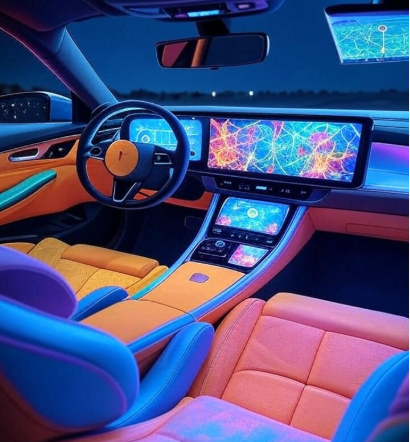In the current technological renaissance of the automotive industry, cars are connected centers of innovation, entertainment, and productivity rather than merely being vehicles. Leading this change is the incorporation of next-generation app experiences, which redefine the driving experience by fusing extended reality (XR), artificial intelligence (AI), and seamless connectivity. Developers can now create immersive, intelligent, and customized in-car apps thanks to Google’s recent innovations, which were demonstrated at Google I/O 2025, especially with Android XR and Gemini. This blog explores the possibilities of creating cutting-edge app experiences for automobiles, how Android XR and Gemini can enable developers to be creative, and the implications for driving in the future.
The Development of App Experiences in Cars
The idea of in-car applications is not new; early connected car technologies were introduced by systems such as General Motors’ OnStar, which was introduced in 1996 and collected data from sensors and GPS to improve driver convenience and safety. But there has been a significant change in the last ten years. With apps that provide real-time navigation, entertainment, and vehicle diagnostics, modern drivers expect their cars to be as intelligent as their smartphones. The market for in-car apps was estimated to be worth $62.6 billion in 2024 and is expected to expand at a compound annual growth rate (CAGR) of 8.9% through 2034 due to the demand for connectivity, safety, and driver assistance.
Car infotainment systems can now use smartphone apps thanks to platforms like Apple CarPlay and Android Auto.
Android XR: A New Frontier for In-Car Apps

Android XR, introduced by Google in late 2024, is a platform designed for extended reality devices, including smart glasses and headsets, but its implications for cars are profound. At Google I/O 2025, Google announced the integration of Android XR with Android Auto, Android Automotive OS, and cars with Google built-in, enabling developers to create spatially aware, immersive app experiences for drivers and passengers. Unlike traditional in-car systems that rely on 2D displays, Android XR introduces 3D interfaces, augmented reality (AR) overlays, and voice-driven interactions, transforming the car into a dynamic digital environment.
For example, Android XR can project holographic navigation cues onto the windshield, providing heads-up directions that blend seamlessly with the real world. This feature, demonstrated at Google I/O 2025, allows drivers to see turn-by-turn directions without taking their eyes off the road, enhancing safety and convenience. For passengers, Android XR can create immersive entertainment experiences, such as watching movies on a virtual screen that appears to float in the car or playing AR-based games that interact with the vehicle’s surroundings when parked.
Gemini: The Experience’s Artificial Intelligence Brain
The true power of Android XR in automobiles lies in its compatibility with Google’s cutting-edge AI assistant, Gemini. Gemini gives in-car apps multimodal capabilities, contextual awareness, and natural language processing, allowing for a level of intelligence beyond voice commands. Apps can anticipate needs, comprehend the driver’s intent, and offer tailored recommendations based on real-time data thanks to Gemini.
Consider a situation in which you are traveling by car to a new city. Without you having to do anything, Gemini, which is built into your car’s Android XR system, can display a 3D map overlay on the windshield, recommend the best route based on traffic, and point out a coffee shop along the way. If you look at a billboard for a performance,
Developing Next-Gen Apps: Resources and Possibilities
The resources and tools that Google announced at Google I/O 2025 demonstrate the company’s dedication to developers. With the addition of new categories and templates, the Car App Library has made it simpler for developers to create apps for Android Auto, Android Automotive OS, and Google-enabled cars. While templates simplify development for common use cases like media playback and navigation, new app categories include immersive games and video experiences. To make sure their apps work on all devices, developers can also test them on Pixel tablets.
Google offers support for OpenXR, Unity, and WebXR for developers wishing to take advantage of Android XR, making it possible to create 3D and augmented reality applications. With these tools, developers can create applications that communicate with the environment of the car, like
The Effect on the Industry and Drivers
Wide-ranging effects result from the incorporation of Android XR and Gemini into automobiles. It translates into a more engaging, customized, and pleasurable experience for drivers. Without fumbling with a phone, apps can now provide real-time entertainment, navigation, and diagnostics, lowering distractions and enhancing safety. Immersion experiences, such as augmented reality games or virtual movie screens, allow passengers to enjoy and unwind during lengthy drives.
This change creates new partnerships and revenue streams for the automotive sector. The increasing demand for connected car solutions is demonstrated by the in-vehicle apps market, which is expected to reach $107.15 billion by 2030. GM is concentrating on energy efficiency, while other automakers like Toyota and General Motors are already making significant investments in in-car apps.
Obstacles and Things to Think About
Developing next-generation app experiences for automobiles presents difficulties despite its potential. Privacy is still an issue because applications that make use of Gemini’s contextual awareness may gather private information like user preferences and location. In order to ensure that Android XR devices adhere to privacy standards, Google is tackling this through user feedback and real-world testing. The intricacy of integrating apps with different in-car systems, like Ford Sync or BlackBerry QNX, which may call for particular APIs and automaker approvals, is another challenge for developers.
Ensuring safety presents another difficulty. Immersion experiences are thrilling, but they need to be planned to reduce distractions, particularly for drivers. Google’s emphasis on voice controls and augmented reality overlays is beneficial, but developers must follow stringent rules to guarantee that apps are safe for use in cars.
The Prospects of In-Car Applications
The future of in-car app experiences appears to be promising. We can anticipate even greater integration with automobiles as Android XR and Gemini develop further. Examples include augmented reality interfaces that highlight road trip attractions or apps that track driver fatigue and recommend breaks. These experiences will be further improved by the rollout of 5G connectivity, which will allow for cloud-based processing for more sophisticated apps and real-time data streaming.
There are countless opportunities for developers. Android XR and Gemini give you the tools to be creative, whether you’re making a productivity app that connects with smart home devices, a game that turns the car into a virtual battlefield, or a navigation app with AR overlays. The increasing use of Android Automotive OS by automakers
How to Begin
Are you prepared to create the newest in-car applications? Start by looking through Google’s Car App Library and Android XR developer resources. The Car Ready Mobile Apps initiative supports modifying pre-existing apps, and the Android Developers Blog provides instructions on how to use the OpenXR and Gemini APIs. Keep up with new tools and templates that are announced at events like Google I/O, and test your apps on Pixel Tablets to make sure they work.
In conclusion
A major advancement in automotive technology, the incorporation of Android XR and Gemini into automobiles presents developers with fresh chances to produce innovative in-car app experiences. These cutting-edge apps, which offer immersive entertainment and hands-free navigation, are poised to transform driving and make it safer, more connected, and more pleasurable. Now is the ideal moment for developers to enter the market and influence the direction of mobility as the in-vehicle app market keeps expanding. The path to innovation is ahead, so fasten your seatbelt and get to work building!



